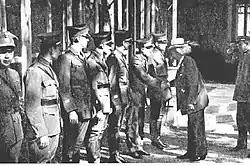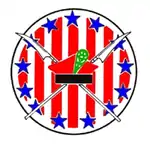Kościuszko's Squadron
The name Kościuszko's Squadron or Kościuszko's Escadrille, is taken from the Polish hero Tadeusz Kościuszko. The name has been borne by several units of the Polish Air Force throughout its history. The unit insignia was designed by Eliott Chess, an American pilot serving with the Polish Army during the Polish-Soviet War. In order to encourage the recruitment of Americans of Polish descent, the Polish military set up a unit called the Polish-American Air Group. It was hoped they could get enough pilots to have two groups The Pulaski Squadron and Kościuszko's Squadron.
| Kościuszko's Squadron | |
|---|---|
 American Aviators of the Kościuszko's Squadron in Poland meeting Premier Ignace Jan Paderewaki [1] | |
| Active | October 1918 |
| Allegiance | |
| Branch | Aéronautique Militaire Military Aeronautics |
| Type | Fighter Squadron |
| Engagements | World War I World War II |
| Insignia | |
| Roundel of the Kościuszko Squadron | |
 |
| Kościuszko's Squadron |
|---|
|
3rd Military Air Escadrille |
Formation
First formed after Poland regained independence following World War I, it consisted of a small group of American volunteers independent of the U.S. State Department or the American Expeditionary Force in Europe.[2] The fliers came from a number of militaries. Members included Ludomi Rayski (Commander and served with the Turkish Air Force), 1st Lt. Jerzy Weber (Served with the Imperial Russian Air Service), First Lt Wladyslaw Konopka, 2nd Lt Aleksander Senkowski (Served with the Austrian Air Service), 2nd Lt Ludwik Idzikowski (Served with the Imperial Russian Air Service). [3]
One of the most famous pilots was Merian C. Cooper, producer of the 1933 movie King Kong, who was decorated for valor by Polish commander-in-chief Józef Piłsudski with the highest Polish military decoration, the Virtuti Militari. During WW II the Kościuszko Squadron was formed by refugee Polish pilots who joined the RAF and played an essential role during the Battle of Britain. [4]
The Kościuszko Squadron emblem depicts the distinctive four-cornered rogatywka (red cap of traditional Polish style) set against a field of seven red vertical stripes on a white background (forming six white stripes as a result) from the Flag of the United States, red and white also being two colors contained in both the Polish and American flags. Behind the red cap is a pair of crossed scythes. Thirteen blue stars encircle the badge, representing the thirteen original American states. [5] The rogatywka cap and scythes commemorate the Kościuszko Uprising of 1794: ten years after General Tadeusz Kościuszko returned to Poland from America, and led the Polish people, many armed only with scythes, in an attempt to liberate Poland from Russia and Prussia.
See also
| Wikimedia Commons has media related to Kościuszko's Squadron. |
- Lafayette Escadrille - French squadron of American pilots
- Blue Army - Polish Army Unit partly made up of North Americans of Polish ancestry
Bibliography
Notes
- The Logan Republican, November 29, 1919, p. 1.
- Cisek 2002, p. 1.
- Cisek 2002.
- Olson & Cloud 2004, p. 124.
- Fiedler 2010.
References
- Cisek, Janusz (2002). Kosciuszko, We Are Here!: American Pilots of the Kosciuszko Squadron in Defense of Poland, 1919-1921. McFarland. ISBN 9780786412402.CS1 maint: ref=harv (link) - Total pages: 256
- Fiedler, Arkady (2010). 303 Squadron: The Legendary Battle of Britain Fighter Squadron. Aquila Polonica. ISBN 9781607720041.CS1 maint: ref=harv (link) - Total pages: 331
- "American Aviators in Poland". The Logan Republican. Logan, Cache, Utah: N.R. Moore. 2019. pp. 1–7. ISSN 2158-2815. OCLC 12654497. Retrieved November 29, 2019.
- Olson, Lynne; Cloud, Stanley (2004). A Question of Honor: The Kosciuszko Squadron: Forgotten Heroes of World War II. Vintage Books. ISBN 9780375726255.CS1 maint: ref=harv (link) - Total pages: 495